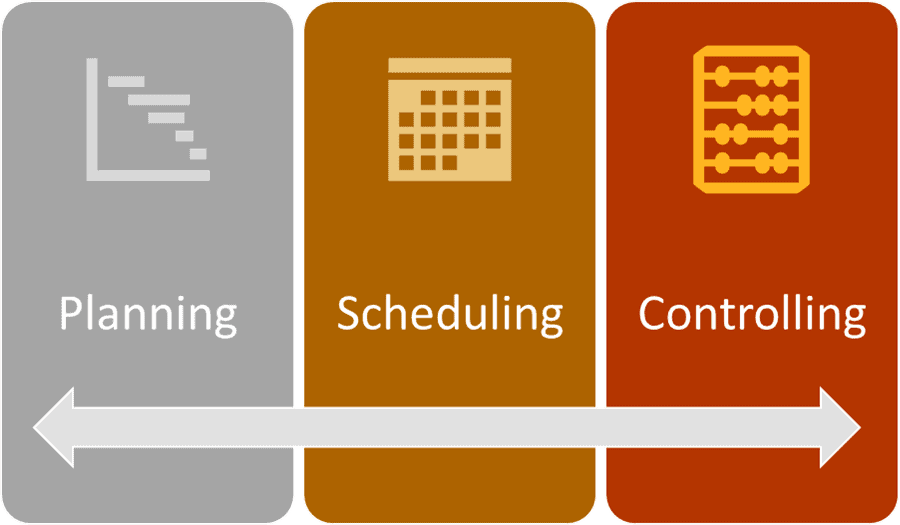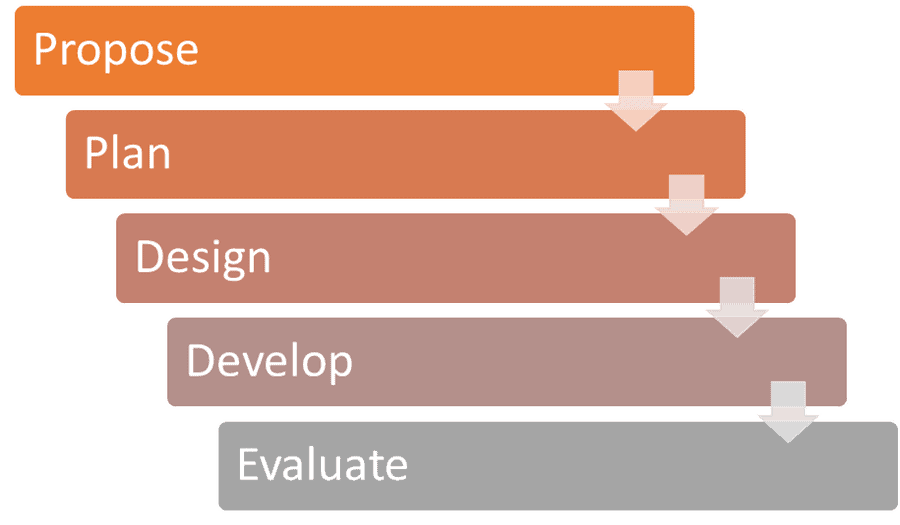
Strong project management practices are vital to a Six Sigma project’s success. Without these practices, a project will often creep. Its scope will change, the time required to implement changes will increase, and understanding of the requirements will falter.
A good project manager keeps an eye on all of the variables and controls them.
Discipline equals freedom.
Jocko
Who Manages a Six Sigma Project?
In Six Sigma project management, senior managers take an active role. They create projects by choosing a business process that needs improvement. However, a project manager – often a Six Sigma Black Belt – will usually lead the project itself.
Project Management Stages

There are three basic stages in Six Sigma project management:
- Planning: You work out what needs to be done to make the project a success.
- Scheduling: You map out how much time it will take your team to complete all the tasks.
- Controlling: You keep track of both of these factors throughout the project and adapt resources, planning, or scheduling so that it stays on track.
Stages differ from project management phases because they aren’t limited to a specific point in time. You’ll find yourself planning, scheduling, and controlling a project all the way through it.
Project Management Phases

Each Six Sigma project has five basic phases. These are discrete, meaning that as one phase ends, another begins. Contrast this with the project stages, which occur throughout the project.
Propose
This is where you put together the vision for the project. You work out what it’s supposed to achieve and why. You talk to stakeholders. And you sell the project.
A common issue that Six Sigma projects face is a lack of business impact for the company. Quantify the bottom-line benefits the project will achieve. as well as the tactical metric improvement.
Plan
You have a high-level vision, and you’ve received approval to move ahead. Your next job is to move down one level and look at what you’ll need to achieve that vision. In this phase, you decide the scope of the project. You need to answer questions like:
- What will you actually deliver?
- Who will work on the project?
- What are the requirements?
- When does it need to be completed?
- What resources will you need?
- What’s your budget?
This is the phase in which you’ll develop the project charter.
Design
If the planning phase is all about the what, the designing phase is all about the how. In this phase, you look at your deliverables. You answer questions like:
- What do our deliverables (outputs) actually look like?
- How will we measure the quality of those outputs?
- How will we monitor our progress?
- When and how will we report project status to stakeholders?
- How will we create our deliverables?
- What will our processes look like?
- What’s our schedule for the project?
Develop
Once you’ve figured out the what and the how, you’re ready to start implementing the project. Use the design documents to develop your deliverables. Monitor the progress of the development. Measure outputs using the metrics you decided on.
Evaluate
Once your development work is done, you need to wrap it up. This includes steps like:
- Tollgate reviews
- Control plans
- Completion
- Project review (aka postmortem, lessons learned.)
- Archiving documentation.
Project Management Phases vs DMAIC
You might have noticed a distinct similarity between the phases mentioned above and the DMAIC phases. It’s no coincidence – the two models have a lot in common. Where they differ, though, is in their purposes. DMAIC is a process improvement cycle. It’s often used as a tool in developing and planning projects. It’s not, however, used to manage projects. That’s why the project management phases don’t match perfectly with the DMAIC cycle.
Project Management Elements
- Schedule time limits
- Allocation of responsibilities
- Communication (reporting methods)
- Trade off methodologies
- Measuring accomplishments vs plans.
- Problem identification (early)
- Correcting problems.
- Risk Identification and Mitigation
- Team elements
Project Management Tools
You have a lot of tools available to use in managing a project. There are dedicated planning tools and tracking tools, as well as analysis and design tools. We’ve listed some of the most commonly used.
Project tracking tools
- Gantt Chart
- Tracking Reporting and Corrective Action System (TRaCAS)
- Project Priority Matrix
- Project Responsibility Matrix
Analysis tools
Planning tools
Six Sigma Project Management Resources
ASQ
The ASQ offers a few project management resources. You’ll need to be a member to view some of the content.
George Eckes
George Eckes has written several books about Six Sigma. They’re renowned for being clear and easy to read while giving the reader some incredibly useful information.
Common Six Sigma Project Management Questions
How long should a Six Sigma project take?
According to George Eckes – 120 days.
What is the main disadvantage of presenting a team with a project of > 160 days?
There’s a lowered expectation of success according to Eckes.
What are the Deliverables of a Lean Six Sigma Project?
Each phase of a Lean Six Sigma project has different deliverables. While there are variations on each project as each project requires the use of different tools, there are similarities.
At a minimum, you should have a project charter to start with. A Stakeholder communication plan is also essential from my experience.
Additionally, I like to schedule regular reviews with my stakeholders on a predictable schedule and certainly with the achievement of a milestone. Your frequency of meeting with your stakeholders will depend upon the nature of your work and their involvement. At the least, I would review the conclusion of each DMAIC phase with them to achieve sign-off.
ASQ Six Sigma Green Belt Project Questions
Question: Which of the following is the key objective of a six sigma project?
(A) Developing detailed control charts for critical processes
(B) Developing a matrix to understand the how’s and what’s of a problem process
(C) Reducing variation in critical processes
(D) Reducing investment costs while improving output quality
Answer:
Six Sigma projects attempt to control processes by getting them under control. That’s the objective. Controlling the variation inherent in a process is the best way to do that. Once you have variation under control you can then improve quality. If you try to improve quality without first reducing variation, you’ll just waste your time. See the Quincunx example for a great visual.
You might develop a matrix to understand the problem or you might use other tools. But developing that matrix is not the object of launching a six sigma project.
At the end of your project, you might create control charts for critical processes. But again, creating those charts is NOT the objective of the project.
You would not necessarily reduce investment costs (although you could) as part of the project, so that’s not the best answer. You certainly would reduce the cost of poor quality, though!


Comments (2)
Commitment Scale link links to Communication plan.
Hi Abdul,
Yes, it does. We moved the commitment scale article to be part of the communication plan. People have been complaining about too many articles so we are combining similar concepts across the board. You’ll find what you need there.
Best, Ted.